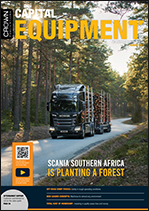 COVER STORY: One tree will be planted for every Scania Sustainability Pioneer who partners with them to drive the shift to a sustainable transport system.
COVER STORY: One tree will be planted for every Scania Sustainability Pioneer who partners with them to drive the shift to a sustainable transport system.
Scania’s sustainable transport solutions include low-emission Euro 5 vehicles, the soon-to-be-launched Scania Super with Euro 6 engines, Natural Gas Vehicles and zero-emission Scania Battery Electric Vehicles.
The trees for the proposed forest will be planted in areas where they have the most impact. Many communities in South Africa lack green spaces. Research links trees to a reduction in crime, better school performance and improved health benefits.
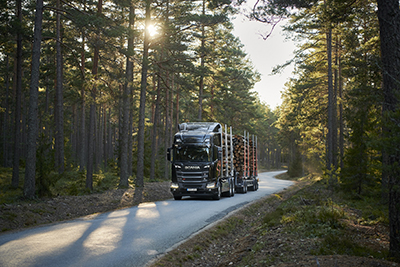 Every tree planted in a Scania Sustainability Pioneer’s name will create a healthy and sustainable community ecosystem while ensuring these business visionaries are forever a part of the environment, they are helping Scania to protect.
Every tree planted in a Scania Sustainability Pioneer’s name will create a healthy and sustainable community ecosystem while ensuring these business visionaries are forever a part of the environment, they are helping Scania to protect.
“Considering that our roads carry more than 70% of all goods transported across South Africa, ensuring the effects of climate change are drastically reduced is a pressing responsibility,” explains Erik Bergvall, Managing Director, Scania Southern Africa.
As the first heavy commercial vehicle manufacturer to set science-based targets aligned to the Paris Agreement, Scania is, together with its sustainably minded customers, taking collective ownership of its role in climate change.
“Already our science-based targets aim to ensure our vehicles produced in 2025 will emit 20% less carbon emissions than those produced in 2015,” says Bergvall.
“To further increase efficiencies, we have introduced optimised vehicle specifications that include better powertrains and further fuel efficiencies.”
When fossil fuels, like diesel burn, they release carbon dioxide. These gases are trapped in the atmosphere, causing temperatures to rise, and leading to climate change.
The transport sector is particularly exposed and vulnerable to the impacts of natural disasters.
Climate change is expected to exacerbate future risks. Extreme weather may disrupt and damage the vital connections that provide access to economic opportunities, healthcare, education and social connections.
In South Africa, transport has been identified as the fastest-growing source of greenhouse emissions, accounting for 10.8% of National GHG Emissions. Direct emissions from the road sector, account for 91.2%.
“The shift to sustainable transport solutions is a collective effort,” says Bergvall.
“We can’t do it alone. By partnering with our Scania Sustainability Pioneers, we are working together to reduce the carbon emissions necessary to limit climate change in Southern Africa.”
TONLY’S NEW RANGE OF DUMP TRUCKS: In the realm of mining and quarrying, Doosan/Develon's pioneering range of Tonly engineering transportation equipment is creating waves of excitement across South Africa. The synergy between Doosan and Develon has given birth to a remarkable lineup of machinery, with the spotlight shining particularly bright on the newly launched Tonly TL859 off-road dump trucks.
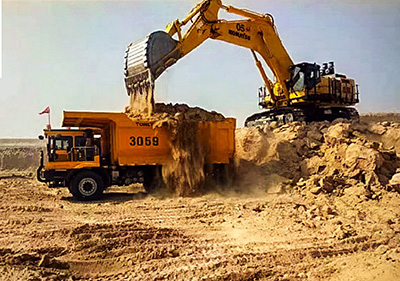 These cutting-edge machines are poised to redefine industry benchmarks and usher in unparalleled efficiencies in off-road operations.
These cutting-edge machines are poised to redefine industry benchmarks and usher in unparalleled efficiencies in off-road operations.
Darrel Holton, Managing Director of DISA Equipment, elaborates on the significance of this revolutionary addition: “The local Doosan/Develon team is pleased to now include Tonly machines in our wide range of mining and construction equipment. Of particular interest to our customers are the newly launched Tonly TL859 off-road dump trucks, which are poised to set new industry standards and drive efficiencies in off-road operations.”
The TL859 series is the result of meticulous research and development undertaken in Indonesia, where the design team focused on integrating key mining dump truck technologies and adaptive applications for large-scale mine site working conditions.
The TL859 AWD 6-by-6 all-wheel drive off-road dump trucks are engineered for optimum performance on soft road surfaces, as well as in wet and muddy working conditions. These trucks feature an electronically controlled engine and an automatic gearbox, accompanied by user-friendly controls that elevate operational efficiency.
At the heart of this robust series lies a high-performance 12L engine, meticulously optimized for exceptional fuel efficiency and dependable power delivery across a broad spectrum of operating scenarios. The automatic transmission boasts an integrated hydraulic retarder that enhances auxiliary braking capabilities for handling heavy loads, thereby enhancing operational safety, even in the most demanding conditions.
The marriage of the transmission design and the hydraulic retarder brings about controlled speed reduction when traversing steep slopes, facilitating extended periods of high-power operation. This advanced arrangement not only mitigates wear on components and tires but also underscores the series' focus on sustainability and longevity.
UNVEILING FUTURE-READY LOADER CONCEPTS: Bobcat, a stalwart in the construction equipment industry, stepped into the spotlight at this year's Demo Days event held in the Czech Republic at the start of the European summer.
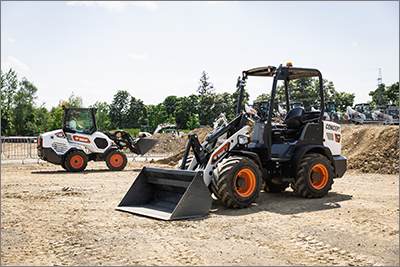 The event captivated the attention of industry aficionados, dealers, and the press from across Europe, the Middle East, and Africa (EMEA).
The event captivated the attention of industry aficionados, dealers, and the press from across Europe, the Middle East, and Africa (EMEA).
As we head into the South African Spring and then summer season, it’s a good opportunity to reflect on Bobcat’s offering in the wheel loader arena, and how these small machines can take on big tasks.
The past five years have witnessed Bobcat's remarkable expansion, with the launch of a multitude of machines and attachments. Bolstered by a commitment to innovation, Bobcat has established its foothold in various domains, from compact wheel loaders to ground maintenance equipment.
A panorama of Bobcat's latest innovations, including the groundbreaking S7X – the world's first all-electric skid-steer loader, alongside a plethora of exciting technological advancements like the MaxControl system with the innovative Kishi physical remote, was on full display during the Bobcat Demo Days event.
The event showed what is in store for Bobcat loyalists and those curious about the brand. In South Africa, it shows the country what is to come – and it is specifically wheel loader technology that enjoyed the bulk of the attention.
The event seamlessly integrated the legacy of tried-and-true Bobcat products with the allure of cutting-edge developments, allowing participants to immerse themselves in the world of Bobcat's wheeled and tracked loaders, mini-excavators, telehandlers, light compaction tools, and an array of attachments, all in live-action scenarios.
A major highlight of this year’s event was the unveiling of the L95 model, an impending addition to Bobcat's compact wheel loader lineup, which sets the stage for future excellence. Bolstered by a robust 75 HP engine, the L95 surges with a top speed of 40 km/h and enhanced lift capacity. The machine's versatility is underlined by multiple Bobcat loader attachments, including the new 1.0 m3 general-purpose bucket and a 1.5 m3 light material bucket, tailored for diverse applications.
Bobcat’s innovation prowess is showcased with a series of concepts that redefine industry standards. The L35 Small Articulated Loader (SAL) and L40 Compact Wheel Loader encapsulate the brand's commitment to versatility and efficiency.
The new MaxControl system, now enhanced by the new Kishi physical remote, takes operator control to unprecedented heights. The unveiling of the S7X, the world's first all-electric skid-steer loader, marks a paradigm shift towards sustainability, while the T-OLED (Transparent Touch OLED Display) and E35z Electro-hydraulic Mini-Excavator equipped with MaxControl remote operation underscore Bobcat's tech-driven future.
Why Investing in quality saves time and money: A bricking machine has a dedicated and limited purpose and is not used daily. That raises the question: Why invest in a premium product for occasional use? Minimizing the initial investment may seem like the way to go; however, not all bricking machines are created equal when it comes to the total cost of ownership.
Bricking Solutions a division of Brokk, available in South Africa through Demolition & Drilling Equipment in Boksburg, is a solution-based brand to make bricking simple. For that to happen, the right machine needs to be in the field doing the work.
Factors such as the design and quality of the machine affect productivity and how well the installation is executed. Plants that want to complete maintenance as quickly as possible and to have the best quality installation must make sure to invest in equipment that is not the least expensive to buy, but the least inexpensive to own.
So how can operations make this distinction? There are a few key indicators to look for to help determine which machine will be the best long-term investment and offer the lowest total cost of ownership.
The most obvious and easily factored-in component of the total cost of ownership is purchase price. While it can be tempting to favour the cheapest possible option, operations must evaluate whether the product offers good value and what the long-term costs might be.
A bargain bricking machine may be constructed from aluminium and galvanized steel or painted wood and steel – making the machine heavy and cumbersome to handle. Such machines can tip the scales at 1,850 kilograms and take five to six crew members, a forklift and 6 to 10 hours to set up – wasting an entire shift simply getting ready to work.
A bricking machine constructed of strong, yet lightweight 6061-T6 aircraft grade aluminium is a lean 1,400 kilograms. A four-person team can easily set up the all-aluminium, pin-together machine in just 60 to 90 minutes, and a larger crew can finish even faster. That allows most of the shift to be used for actual installation and brings the job to completion more quickly.
Despite the heftiness of bargain machines, they can often lack durability. They often are manufactured with lower-quality material that is not welded to the highest industry standards, resulting in premature cracking. These machines have a lifespan of no more than a decade and sometimes three years or less. With proper maintenance, however, a machine built with high-quality aluminum has a minimum lifespan of 20 years, offering many more years of efficient, quality performance. That means operations could end up replacing the bargain machine two to six times over 20 years while a higher quality machine could perform reliably throughout that time. At that point, the bargain machine starts costing more than the single investment in a higher quality option.
AFTERMARKET SUPPORT: Driving home the importance of quality equipment and unmatched service infrastructure, Pilot Crushtec argues that the numbers that really matter are never found on a sales quotation. Rather, the numbers deserving as much attention as the quoted price are those that reflect decades of investment in quality engineering, service excellence and customer support.
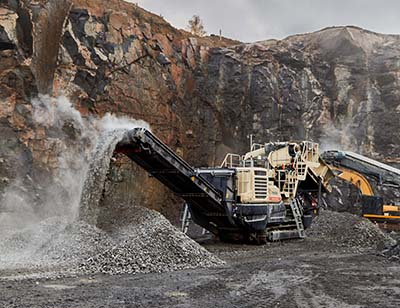 While the quotation for an item of equipment reflects its upfront price, it says nothing about the history, experience, product quality and service infrastructure required to sustain optimal production levels for the customer.
While the quotation for an item of equipment reflects its upfront price, it says nothing about the history, experience, product quality and service infrastructure required to sustain optimal production levels for the customer.
“Sustainable and reliable production is at the heart of any crushing operation, and this is what customers are really paying for when they purchase capital equipment,” says Francois Marais, Sales and Marketing Director at Pilot Crushtec.
“For this reason, the numbers that matter are those that reflect a supply partner’s ability to help customers meet their vital deliverables.”
Marais highlights that Pilot Crushtec has spent 33 years building a reputation for its quality of product and its outstanding service levels. Its engineering prowess has already seen over 300 Pilot Crushtec modular plants placed into operation with customers, with over 2,000 mobile crushers, screens and conveyors sold and commissioned.
“Other numbers that matter include the 170 modular cone crushers and the 200 modular jaw crushers that we have sold into the market,” he explains. “We estimate that our equipment has to date processed about 5 billion tonnes of material – in around 1,000 different applications and processes.”
He notes that, all too often, equipment purchases are made purely based on capital pricing. Down the line, he says, it may be realised that the necessary technical assistance, experience or parts are not readily available to support the equipment. Pilot Crushtec has made a strategic philosophy of its customer commitment, by investing heavily and continuously in service infrastructure, spares and wear parts and continuous training of its people.
“For instance, we train, develop and retain the skills necessary to keep customers’ equipment up and running – to avoid costly downtime that could threaten their contracts and reputations,” he says. “This includes our 15 full-time service technicians, who travel a million kilometres a year to see customers and deliver quality support.”






